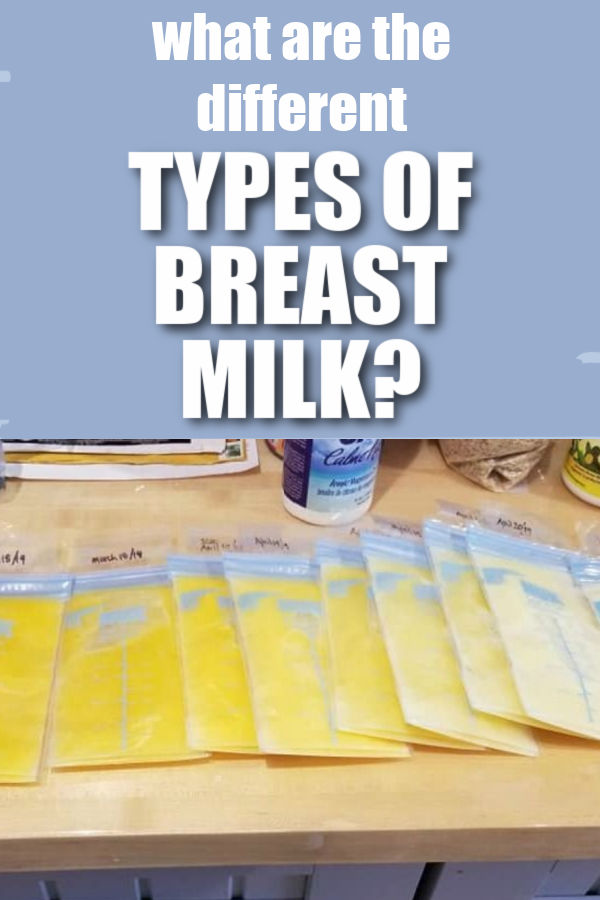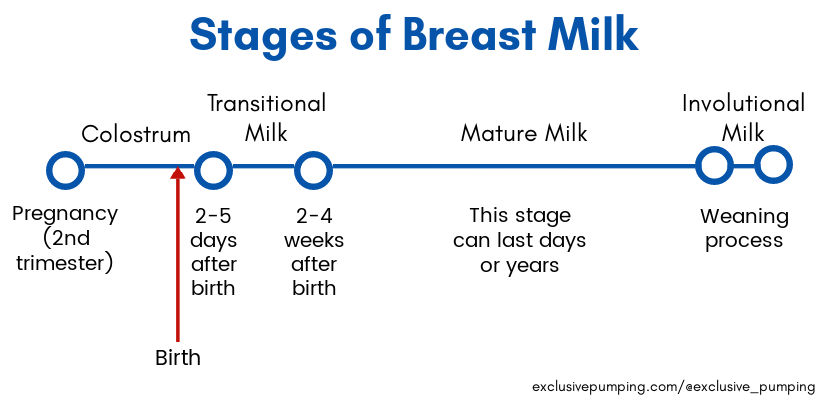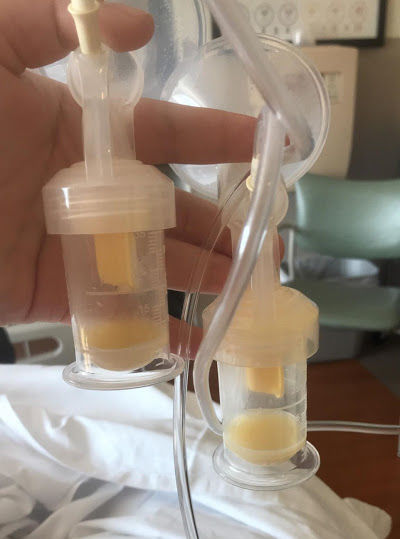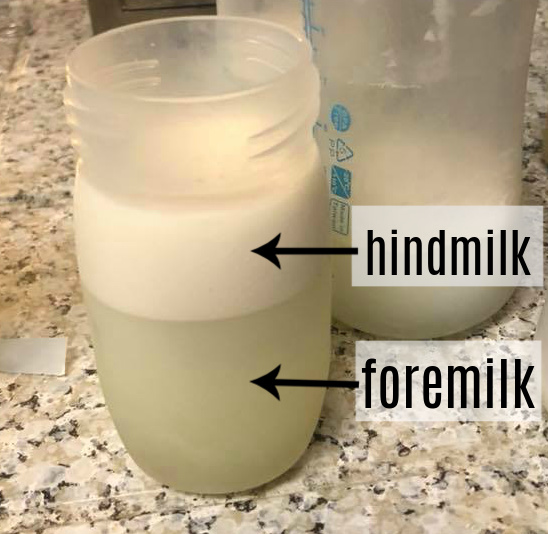You may have heard that there are all of these different types of breast milk – colostrum, transitional milk, mature milk, foremilk, and hindmilk. What exactly are these distinct kinds of milk? How are they different?

This post may contain affiliate links, which means if you click a link and take action, I may make a small commission at no additional cost to you. I only recommend products I love! More information here.
Each of these types of breast milk is produced at different stages – both at different stages of breastfeeding, as your baby gets older, as well as at different points in a single feeding or pumping session.
Let’s talk first about the different types of breast milk that you see as your baby gets older.
Types of Breast Milk at Different Stages

There are four stages of breast milk that you’ll see as your baby gets older:
- Colostrum is produced by your breasts during pregnancy up until two to five days after birth. (Some people leak colostrum during pregnancy and others don’t – both are normal.)
- Transitional milk is produced starting from two to five days after birth, when your milk “comes in,” until two to four weeks postpartum.
- Mature milk is then produced from two to four weeks postpartum until weaning. This phase can last anywhere from several days up to many years, depending on how long the parent removes milk from the breast.
- Involutional milk is the milk that your breasts make at the very end of lactation.
Let’s talk about how these types of breast milk are different.
Colostrum

As noted above, colostrum is the first milk that your breasts produce, and it is a thick milk that is ideal for newborns. Colostrum has 50 to 60 calories per 100 milliliters, or 15 to 17 calories per ounce.
The macronutrients in colostrum break down as follows:
- Carbohydrates: 50-62 g/L
- Protein: 14-16 g/L
- Fat: 15-20 g/L
From United Nations University:
Notably, colostrum is rich in secretory IgA, lactoferrin, Vitamin A, and sodium compared with mature milk, but it has relatively low concentrations of fat, lactose and Vitamin B1.
You may be able to “harvest” colostrum while you’re pregnant. More info on that here.
Mature Milk

I’m going to talk about mature milk next, even though transitional milk is produced after colostrum. That’s because the best way to describe the composition of transitional milk is to say it’s in between what we see in colostrum and in mature milk.
Mature milk is produced from two to four weeks postpartum until weaning. It contains 65 to 70 calories per 100 milliliters, or 20 to 22 calories per ounce.
Compared to colostrum, mature milk has increased carbohydrates and fats, but less protein:
- Carbohydrates: 60-70 g/L
- Protein: 8-10 g/L
- Fat: 35-40 g/L
The composition of mature milk also changes throughout the first year. As time goes on, breast milk generally has less zinc, as well as other nutrients. However, some nutrients also increase over time.
Transitional Milk
As noted above, transitional milk represents the gradual transition between colostrum and mature milk.
Transitional milk starts when your milk comes in, and it ends when your milk becomes “mature” – but there’s no set time that that happens. The exact timing varies from person to person, and the changes in composition change aren’t abrupt.
Instead, it’s a gradual change with increasing amount of fats and carbohydrates, and decreasing amounts of protein.
Involutional Milk
The last stage is involutional milk, which is the milk produced at the end of lactation.
This milk is lower in lactose and it has high concentrations of protein, fat and sodium.
Types of Breast Milk in a Pumping Session
In addition to the different types of breast milk that are produced over the first year, we also have different types of breast milk that occur over the course of a single feeding.
These are foremilk and hindmilk, and the difference between them is the amount of fat and fat-soluble components such as Vitamin A.

Foremilk
In between feedings or pumping sessions, milk collects in the breasts. When your milk lets down, the fat, which is more dense, tends to stay stuck further back in the milk ducts.
This means that milk at the beginning of a pumping session is generally less fatty and more watery than later on.
Hindmilk
As the feeding or pumping session progresses, the fatty globules are dislodged and the milk that you are producing gets fattier.
Like transitional milk, which gradually becomes more mature over time, it’s not an abrupt switch. As time goes on, the composition of the milk slowly changes and starts to contain more fat.
Breast milk is breast milk
I wanted to provide this information about types of breast milk to give you more insight into what you’re producing, and to clarify any confusion from things you may have heard about your milk maybe not being fatty enough, or not being “good” anymore after a certain time.
However, there isn’t anything you necessarily need to do with this information or for you to be concerned about. (The potential exception to this is foremilk/hindmilk imbalance, which you can read more about here.)
Do you have any questions about the different types of breast milk over the stages of your baby’s life or over the course of a feeding? Feel free to ask in the comments!
References- Bonyata, Kelly. “Foremilk and hindmilk – what does this mean?” Kellymom https://kellymom.com/bf/got-milk/basics/foremilk-hindmilk/
- Prentice, Ann. “Constituents of human milk.” United Nations University https://archive.unu.edu/unupress/food/8F174e/8F174E04.htm
- Su Yeong Kim, MD, Dae Yong Yi, MD, PhD. “Components of human breast milk: from macronutrient to microbiome and microRNA.” Korean Journal of Pediatrics https://www.e-cep.org/upload/pdf/cep-2020-00059.pdf












